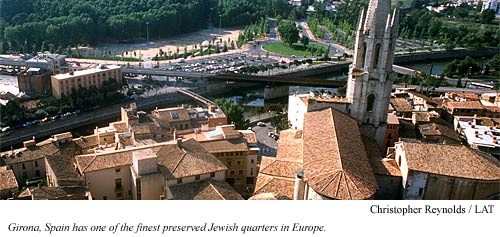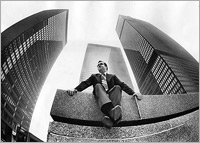CAMP ROSTOCK, Germany—Klaus had tromped through forests and across fields, marching 15 miles back here to his ramshackle tent at 3:00 in the morning, so it’s understandable that he was too beat to be euphoric. He’d taken whacks from billy clubs and swallowed pepper spray as he and more than 10,000 demonstrators — who employed a kamikaze-like “five finger” tactic, in which their groups split abruptly and individuals sprinted in all directions — broke through police lines, blockaded roads and railways, and claimed victory in their bid to disrupt the G8 summit.
Year: 2007
After the Storm
ROSTOCK, Germany—If you dress head to foot in black, set cars on fire, launch stones and beer bottles at police, and brave hand-to-hand scuffles amid clouds of tear gas with choppers thundering overhead, best bet is you’ll make the evening news. Which is too bad, because in the case of Saturday’s late-afternoon riots in Rostock, the images of unrest have obscured and altered what most of us adults would have called the real story.
Lessons in Clean Living
As part of the new Bauhaus permanent exhibit in Dessau, Germany, the historic home of Wassily Kandinsky and Paul Klee is surprisingly sparse. Aside from a few photos of the middle-aged artists posing with rakish smiles, the unadorned, recently refurbished building where they once lived and worked serves as a testament to the movement’s functional “design for living” philosophy. Nestled among pine trees alongside the half-dozen other Masters’ Houses that architect and Bauhaus founder Walter Gropius built in the 1920s, the angular building features sprawling windows, spacious workshops, wine-red floors and pastel-green stairwells. It is the radiant symbol of an avant-garde movement whose activity was cut short – and one that people are now clamoring to rediscover.
With Sephardic Routes, Spain Connects with Jewish History

GIRONA, Spain—For Aida Oceransky, life as a Jew in Spain today isn’t the silent burden it used to be. When she emigrated here from her native Mexico in 1968, Oceransky didn’t dare talk about her family’s Ukrainian Jewish past. All the Jews she knew in the 1970s and ’80s went to Mass. Even a decade ago, “you couldn’t find anything on Judaism in Spain – a magazine, a book, nothing,” she said.
The iMac as Bauhaus’s Progeny

Toronto Star File Photos
Products of the Bauhaus design movement are more findable than you might expect from such an avant-garde, long-ago phenomenon. One example is the Toronto Dominion Centre by architect Mies van der Rohe.
BERLIN—It’s curious to see a building as a living, breathing thing.
That was my first thought some weeks ago on visiting the Bauhaus home of Wassily Kandinsky and Paul Klee, which has been renovated and turned into a museum in Dessau, the small German city on the Elbe River where the artists lived and worked between 1925 and 1932.
Historic Revival
Once haunted by memories of the Holocaust, Berlin has become one of the most Jewish-friendly places on the planet. The German capital boasts an annual Jewish film festival and Jewish culture festival, while performances of Jewish plays attract regular audiences at the Bamah Jewish Theater. Visitors can view exhibits on emigration at the Jewish Museum; the music-minded can take in klezmer concerts performed by the Berlin Philharmonic.
Jonathan Safran Foer To Release English Version of Haggadah
Jonathan Safran Foer will be releasing a new English version of the Passover Haggadah, the best-selling novelist recently confirmed, speaking to a packed German audience at the American Academy in Berlin’s lakeside villa on the outskirts of the capital.
BERLINALE IN REVIEW
They showed us war and apartheid and dictatorship. They debuted actors as directors, and they scored top prizes for filmmakers in countries known for hardly winning any, like China, Israel and Argentina.
Bye-Bye to the Aye-Aye
You’ve probably never seen an aye-aye. And you may never want to see one. It’s a bizarre, ugly-looking creature – sort of a cross between a wolverine, a koala, and a raccoon with big ears; yellowish, gremlinlike eyes; and a giant bushy tail. Conservation biologists say this one-of-a-kind critter from Madagascar – which uses razor-sharp incisor teeth to tear off sections of tree bark, and a long, narrow middle finger to scoop out the insects inside – represents millions of years of independent evolution and is now verging on extinction. (Click here to see the aye-aye in action.) Yes, we’re talking about something grotesque here, so grotesque, in fact, that locals consider it to be an evil omen and kill the animal on sight. But losing it would mean the collapse of an entire branch of the mammalian evolutionary tree. Unless the conservationists can persuade us to help protect an ugly and uncharismatic animal, all this genetic history will be gone forever. How do you get people to care about an aye-aye?
Canadians lauded at Berlinale
Following hot premiere screenings and the film’s sale to markets in Canada and Portugal, The Tracey Fragments earned Kingston, Ont.-born director Bruce McDonald the Manfred Salzgeber Prize awarded for innovative films at the Berlin film festival, which ended here yesterday.